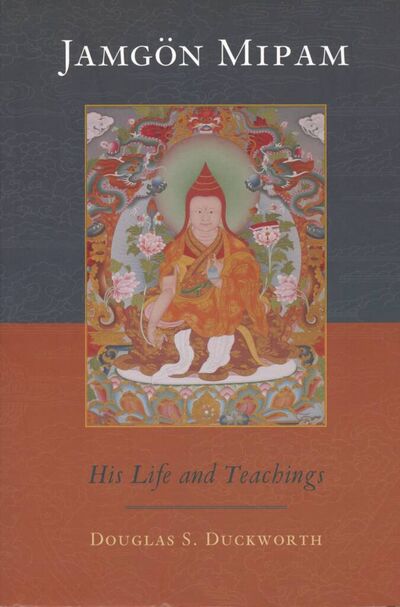No edit summary |
No edit summary |
||
| Line 9: | Line 9: | ||
}} | }} | ||
|FullTextRead=No | |FullTextRead=No | ||
|BookToc=**''[[{{BASEPAGENAME}}/Introduction|Introduction]]'' vii | |||
*Part One: Life and Context | |||
**One. Mipam's Life 3 | |||
**Two. Background of Buddhism in India 17 | |||
**Three. Buddhist Identity in Tibet 39 | |||
**Four. Survey of Mipam's Works 55 | |||
*Part Two: Overview of Mipam's Buddhist Works | |||
**Five. Unity 67 | |||
**Six. Mind-Only and the Middle Way 81 | |||
**Seven. Emptiness and the Nonconceptual 99 | |||
**Eight. Immanent Wisdom 119 | |||
**Conclusion 135 | |||
*Part Three: Select Translations | |||
**1. Emptiness and Analysis 141 | |||
**2. Conceiving the Inconceivable 142 | |||
**3. Unity and Buddha-Nature 143 | |||
**4. Steps to the Middle Way 145 | |||
**5. No-Self 146 | |||
**6. Unmistaken Emptiness 147 | |||
**7. Meditation on Emptiness 149 | |||
**8. Mind- Only and the Middle Way 150 | |||
**9. Mind-Only and the Middle Way II 151 | |||
**10. Reflexive Awareness 155 | |||
**11. Consequence and Autonomy 157 | |||
**12. Consequence and Autonomy II 158 | |||
**13. Two Truths 160 | |||
**14. Unconditioned Buddha-Nature 163 | |||
**15. Appearance and Reality 167 | |||
**16. From the Two Wheels of Sutra to Tantra 169 | |||
**17. EstablishingAppearancesasDivine 170 | |||
**18. Fourfold Valid Cognition 173 | |||
**19. Practical Advice for Beginners 175 | |||
**20. Practical Advice for Monastics 176 | |||
**21. Practical Advice on the Path of Illusion 179 | |||
**22. Stages to Calm Abiding 182 | |||
**23. Stillness, Movement, and Awareness in the Great Seal 187 | |||
**24. Method for Sustaining the Nature of Awareness 189 | |||
**25. A Quintessential Instruction on the Vital Point in Three Statements 191 | |||
**26. Ground, Path, and Fruition of the Great Perfection 192 | |||
**27. Bringing Afflictions onto the Path 194 | |||
**28. Mind and Wisdom 196 | |||
**29. Sutra and Tantra 198 | |||
**30. Sword of Intelligence: Method for Meditating on Bodhicitta 201 | |||
**31. Lily of Wisdom s Presence 204 | |||
**32. Verse of Auspiciousness 208 | |||
**''Acknowledgments'' 209 | |||
**''[[{{BASEPAGENAME}}/Notes|Notes]]'' 211 | |||
**''[[{{BASEPAGENAME}}/Glossary|Glossary]]'' 225 | |||
**''[[{{BASEPAGENAME}}/Bibliography|Bibliography]]'' 229 | |||
**''[[{{BASEPAGENAME}}/Index|Index]]'' 239 | |||
|AddRelatedTab=Yes | |AddRelatedTab=Yes | ||
|QuotesTabContent={{ Blockquote | Since wisdom is unconditioned, it cannot be produced by anything, and for this reason, wisdom must be present from the primordial beginning as the true nature, the buddha-nature, of all sentient beings. | pp. 119-120 }} | |QuotesTabContent={{ Blockquote | Since wisdom is unconditioned, it cannot be produced by anything, and for this reason, wisdom must be present from the primordial beginning as the true nature, the buddha-nature, of all sentient beings. | pp. 119-120 }} | ||
|PostStatus=Needs Copy Editing | |PostStatus=Needs Copy Editing | ||
}} | }} | ||
Revision as of 09:44, 10 September 2018
Jamgön Mipam (1846-1912) is one of the most extraordinary figures in the history of Tibet. Monk, mystic, and brilliant philosopher, he shaped the trajectory of Tibetan Buddhism's Nyingma school. This introduction provides a most concise entrée to this great luminary's life and work. The first section gives a general context for understanding Mipam's life. Part Two gives an overview of Mipam's interpretation of Buddhism, examining his major themes, and devoting particular attention to his articulation of the Buddhist conception of emptiness. Part Three presents a representative sampling of Mipam's writings. (Source: Shambhala Publications)
| Citation | Duckworth, Douglas S. Jamgön Mipham: His Life and Teachings. Boston: Shambhala Publications, 2011. |
|---|---|


